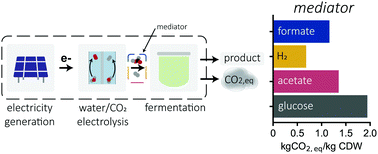A comparative life cycle analysis of electromicrobial production systems†
Abstract
Electromicrobial production (EMP) processes, in which electricity or electrochemically-derived mediator molecules serve as energy sources to drive biochemical processes, represent an attractive strategy for the conversion of CO2 into carbon-based products. However, these systems have yet to be employed on an industrial scale, limiting our understanding of their potential performance and environmental benefits/impacts. We describe the development and application of a comprehensive framework to analyze EMP systems relying on reactor, process, and life cycle impact models. This framework is used to analyze three proposed EMP systems relying on formate, H2, and acetate as intermediate molecules, each producing three hypothetical products: biomass, lactic acid, and industrial enzymes. Physics-based bioreactor models predict that EMP systems can achieve productivities up to 0.65 g L−1 h−1 for biomass production and 0.42 g L−1 h−1 for the production of lactic acid. Despite improved solubility of formate as a substrate, formate-fed EMP systems do not lead to improved productivities compared to H2-fed systems due to O2 gas–liquid mass transfer limitations (for biomass and enzymes) or salinity-induced toxicity issues (for lactic acid). Process models revealed that substrate generation was by far the largest energy demand of the EMP systems, followed by carbon capture and ammonia production, while energy required for gas–liquid mass transfer and fluid mixing accounted for only a small fraction of the systems’ energy footprints. Life cycle impact model results demonstrated that EMP systems can achieve a smaller carbon footprint than traditional bioprocessing strategies provided the electric grid supplying electricity to the EMP system is composed of at least 90% renewable energy sources. For each of the three products we consider, the H2-mediated Knallgas bacteria system achieves the lowest overall global warming potential, indicating that this EMP strategy may be best-suited for industrial efforts based on current technology. EMP systems also would use ∼95% less land compared to traditional bioprocesses. We also identify environmental hotspots and process limitations that are key targets for future engineering and research efforts for each EMP system. Our analysis demonstrates the utility of an integrated assessment framework and should help guide the design of working, scalable, and sustainable electromicrobial production systems.



 Please wait while we load your content...
Please wait while we load your content...